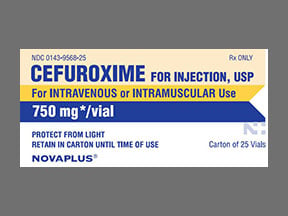
Cefuroxime Coupons & Savings Card – Discount Prices from $79.18
My prescription
Edit
750MG, Cefuroxime (30 Solution Reconstituteds)
Select pharmacy

CVS
$104.28
COUPON PRICE
Walmart
$79.18
COUPON PRICE
Walgreens
$87.30
COUPON PRICE
Albertsons
$95.04
COUPON PRICEFree Cefuroxime Savings Card

Walmart
$79.18
Show this coupon to your pharmacist
ID
LHC33BADF8
PCN
CHIPPO
BIN
019876
GRP
LHX
This coupon is not insurance
More prescriptions for urinary tract infection
More prescriptions for urinary tract infection
Cefuroxime dosage forms
Dosage Quantity Price from Per unit 750MG 30 Solution Reconstituteds $79.18 $2.64 750MG 60 Solution Reconstituteds $163.36 $2.72 750MG 90 Solution Reconstituteds $243.90 $2.71
| Dosage | Quantity | Price from | Per unit |
|---|---|---|---|
| 750MG | 30 Solution Reconstituteds | $79.18 | $2.64 |
| 750MG | 60 Solution Reconstituteds | $163.36 | $2.72 |
| 750MG | 90 Solution Reconstituteds | $243.90 | $2.71 |
Cefuroxime Warnings
This medication comes with important safety warnings that must be carefully considered to ensure your well-being. It is vital to consult with your healthcare provider if you have any concerns regarding these risks.
Severe Allergic Reactions: There is a potential for severe allergic reactions to cefuroxime, which can be life-threatening. Symptoms may include facial swelling, anaphylaxis (e.g., throat closure), shock, hives, rash, red skin, and swelling of the lips or tongue. If you have a history of allergies to antibiotics, particularly penicillin or cephalosporin antibiotics, inform your healthcare provider to assess your risk. Seek immediate medical attention if you experience any of these symptoms while taking cefuroxime.
Clostridioides difficile Infection: The use of cefuroxime, like all antibiotics, can increase the risk of developing an infection with Clostridioides difficile (C. diff). This occurs because antibiotics can disrupt your gut microbiome, allowing C. diff to proliferate and potentially cause life-threatening diarrhea.
Drug-Resistant Bacteria Development: It is crucial to take cefuroxime exactly as prescribed. Deviating from the prescribed duration, whether shorter or longer, or using it for inappropriate illnesses can lead to the development of drug-resistant bacteria. Such infections can be severe, life-threatening, and difficult to treat.
The following contraindications must be reviewed before starting this medication, as they may pose serious health risks:
- Severe Allergy to Beta-Lactam Antibiotics: If you have a known severe allergy to beta-lactam antibiotics such as penicillin, amoxicillin (Amoxil), or cephalexin (Keflex), you should avoid taking cefuroxime. Always discuss your medical history with your healthcare provider for a safe treatment plan.
Cefuroxime Side Effects
Common side effects:
- swelling at the injection site
- redness at the injection site
- pain at the injection site
- diarrhea
- nausea
- vomiting
Less common but important to monitor:
- low appetite
- stomach pain or cramps
- headaches
- chills
- rash
- itching
Serious side effects:
- allergic reaction (rash, hives, blisters, swelling of the lips or tongue, trouble breathing)
- intestinal issue caused by C. difficile (persistent diarrhea, fever, abdominal pain)
- oral thrush
- yeast infection (white patches in the mouth or changes in vaginal discharge)
- severe dizziness
- trouble breathing
